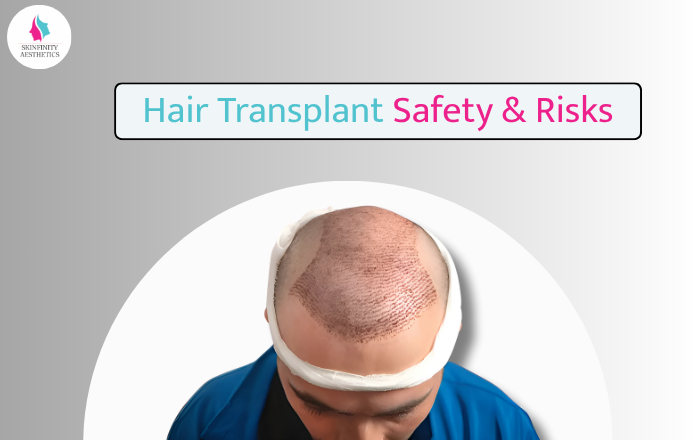Hair loss can affect your confidence and make you feel older than you are. Many people consider a hair transplant to bring back what they’ve lost — not just hair, but a bit of self-assurance. But one big question stops most people from taking the next step: Is a hair transplant safe?
If you’re asking yourself the same thing, you’re in the right place. This blog will walk you through what hair transplant surgery involves, the possible side effects, risks, and what to expect. We’ll also share tips to help you stay safe during the process and suggest a trusted hair transplant surgeon in Airoli if you’re considering the procedure.
What is a Hair Transplant?
A hair transplant is a medical procedure that moves hair from one part of your body (usually the back or sides of the head) to the area where you’re losing hair. It’s commonly used to treat male pattern baldness, but it can also help women and people with thinning hair due to injury or illness.
There are two main methods:
- FUT (Follicular Unit Transplantation): A strip of skin with hair is removed, and the hair is transplanted to the bald area.
- FUE (Follicular Unit Extraction): Individual hair follicles are taken from the donor area and placed into the thinning or bald area.
Both methods are performed by trained surgeons and can give natural-looking results.
Is Hair Transplant Safe? Here’s What You Need to Know
Generally, yes — hair transplants are considered safe when performed by a skilled surgeon in a clean and well-maintained clinic. The procedure is common and has been done for many years with improved techniques.
Most patients experience little to no complications when they follow proper pre- and post-procedure instructions. But, like any medical treatment, there are some risks involved, which we’ll explore below.
Common Side Effects After a Hair Transplant
After a hair transplant, your scalp may feel sore or itchy. These side effects are temporary and usually clear up in a few days to a couple of weeks. Common ones include:
- Swelling of the scalp or forehead
- Itching or tightness in the area
- Scabbing or crust formation on the transplanted area
- Mild pain or discomfort
- Redness or sensitivity
You might also experience something called “shock loss,” where the transplanted hairs fall out before they start growing again. This is normal and part of the healing process.
Rare But Serious Risks to Be Aware Of
While most people recover without issues, it’s important to know the possible risks, especially if you’re not a good candidate or the clinic is not experienced.
- Infection: Rare, but can happen if the area isn’t kept clean
- Poor hair growth: Sometimes the transplanted hair doesn’t grow as expected
- Unnatural hairline: If not done carefully, the new hair may not blend well
- Scarring: Some people may develop thick scars, especially with FUT
- Numbness: Loss of feeling in the treated area may last for weeks or months
Always make sure to follow your surgeon’s instructions and attend all follow-up appointments to reduce these risks.
Who Should Avoid Hair Transplants?
Not everyone is a good fit for a hair transplant. If you have certain medical conditions or poor scalp health, you may need to consider other options.
- People with uncontrolled diabetes or heart problems
- Those who don’t have enough donor hair
- Individuals with unrealistic expectations
- People with scalp infections or skin disorders
- Those who experience ongoing hair loss that hasn’t stabilized yet
Always have a consultation first to find out if it’s the right time for you.
How to Make Sure Your Hair Transplant is Safe
Here are some tips to stay safe and make the most of your hair transplant:
- Choose a qualified and experienced surgeon
- Look at before-and-after photos of past patients
- Read online reviews and patient feedback
- Ask about the procedure, side effects, and recovery time
- Follow all pre- and post-surgery instructions carefully
It’s also important to take time off work to rest and let your body heal properly.
Why Choosing the Right Clinic Matters
The success of your hair transplant depends a lot on where you get it done. Some people look for cheaper options without checking the background of the clinic or doctor — and that can lead to poor results or complications.
When choosing a clinic:
- Check if the doctor is well-trained in hair restoration
- Ask how many procedures they’ve done
- Make sure the clinic follows health and safety rules
- Visit the clinic in person if possible to see the environment
FAQs About Hair Transplant Safety
1. Is a hair transplant safe for women?
Yes, women with thinning hair or hair loss from traction or injury can get safe and successful results, depending on the cause of the hair loss.
2. How long do side effects last after surgery?
Most side effects go away within 7–14 days. Redness and swelling may last a bit longer for some people.
3. Are there non-surgical options for hair loss?
Yes, treatments like PRP therapy, medications (like minoxidil or finasteride), and lifestyle changes may help in early stages.
Thinking About a Hair Transplant?
If you’re near Airoli or Navi Mumbai and looking for someone you can trust, consider Dr. Priyanka Tambe, a well-known Hair Transplant Surgeon in Airoli at Skinfinity Aesthetics Laser Clinic.
She has helped many patients with safe and natural-looking hair restoration. The clinic offers a calm, hygienic environment where your questions and concerns are addressed clearly.
📍 Location: Skinfinity Aesthetics, Airoli, Navi Mumbai
📞 Contact: Book your consultation today to take the first step toward feeling better about your hair.
